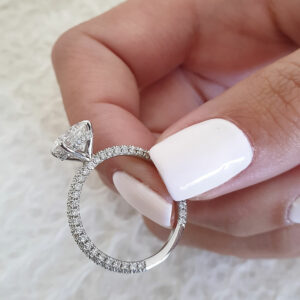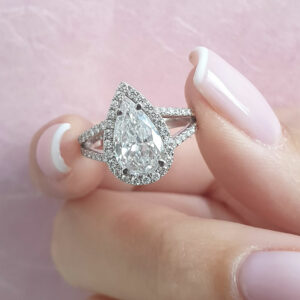No products in the cart.
- Account
-
Free Insured Shipping
30 days Free Returns & Exchange
Design by style
Free Insured Shipping
30 days Free Returns & Exchange

There are so many different types of engagement rings settings to choose from. It can be very overwhelming to know what to choose. It can also be overwhelming to know what all the different engagement ring settings are called in order to articulate what you want if you are looking to customize a ring. We’re here to help break down the most commonly used types of settings and which diamond cuts work best for all of them.
This is the most common type of engagement ring setting. A solitaire setting is just a simple band with prongs holding up the diamond. This is a great choice for an engagement ring because it works for so many different styles. You can wear the ring alone for a simple look or stack it with different bands to change up the style any day of the week. This setting style works well with any diamond cut.
A halo is like a diamond encrusted picture frame that goes around the center stone of a ring. A hidden halo is a band of diamonds that wraps around the prongs of the ring or the base of the prongs and can only be seen underneath the diamond. Adding a halo or a hidden halo is a great way to add a bit of flair to your engagement ring setting without making the ring too trendy. It adds an aspect of visual interest to the ring but in a very classic way. A halo can make your center stone appear much larger and a hidden halo can add a very simple yet beautiful detail from underneath the diamond. These setting styles work well with any diamond cut, but we especially love halos with any rounded shape like round brilliants, ovals, and cushions.
A pave engagement ring setting is also an excellent way to add some interest to your engagement ring while keeping a timeless look. A pave setting is similar to a solitaire setting except the band is encrusted with tiny diamonds. You can have these diamonds go halfway around the band, 3/4 way around the band, or around the entire band of the engagement ring setting. There are also three row pave settings which have diamonds on the face of the band but also on the sides of the band so that the entire setting is encrusted in diamonds. The amount of diamonds you add really depends on personal preference. A pave setting brings a very luxurious look to any engagement ring, but is still a very classic and timeless choice. This setting choice works for any diamond cut.
A split shank engagement ring setting is when the band of the engagement ring splits in to two bands and appears as if there are two different bands supporting the center stone. This is a really unique and cool option that is not super common, but looks incredible specifically with elongated diamond shapes. This is a great option if you’d like more finger coverage from your engagement ring setting but don’t want the bulkiness of a thick band. The split design creates some airiness in the design of the ring making it look sleek and elegant. This setting choice works best with very elongated ovals, movals, marquise, and elongated cushions.
A cathedral engagement ring setting is a slightly more statement setting. It is when the band of the setting curves up to meet the diamond on either side instead of forming a circle. There are many types of cathedral settings but they often have intricate designs underneath the diamond and seem to look like a tiny bridge structure. This type of setting adds a special detail to any ring. You can have a cathedral setting with a pave band or a cathedral setting with a diamond inlay in the structure. The possibilities are endless. A cathedral setting works with any cut diamond but we’re currently obsessed with setting an emerald in one for a modern and elegant look.
A three stone engagement ring setting is usually an engagement ring with a center diamond flanked by two smaller diamonds. The diamonds can be any shape and size. There are so many ways to create a three stone ring. The most common way to wear a three stone ring is to have a center stone that is one shape and two side stones of a different shape that are symmetrical to each other. That being said, the possibilities are endless with three stone rings and don’t have to be limited to the most common look. You can have a three stone ring with all the same diamond cuts or a three stone ring that is asymmetrical. The choice is yours. Three stone rings are super unique and are perfect for someone looking for a more glam look. Three stone rings can be made with any diamond shape in any size.
A two tone setting is when the prongs of the setting are a different color from the band. They are most commonly used for yellow gold or rose gold bands and often have white gold prongs. The purpose of this is to have the prongs blend in with the diamond to be less noticeable. There is nothing wrong with the prongs being noticeable, but it’s just a matter of personal preference. The most common uses of two tone rings are white prongs for a typical white diamond, yellow gold prongs for a fancy yellow diamond, and rose gold prongs for a fancy red or pink diamond.
We have seen a recent rise in popularity of the east to west setting. It is by far the least common of all the engagement ring settings listed but it’s definitely a cool look that is worth mentioning. An east to west setting is when an elongated diamond sits on the setting horizontally instead of vertically. It’s not usually the look one pictures for an engagement ring, but it’s perfect for someone that is not looking for the traditional engagement ring setting. This setting works perfectly for emerald cut diamonds, ovals, radiants, or elongated cushions.


Free Shipping
We offer free shipping for both domestic and international orders.
Secure Payment Methods
Via Visa, American Express, MasterCard, Stripe.
Returns
You have 30 days for exchanges & returns. This does not apply to custom orders (unless stated otherwise).
